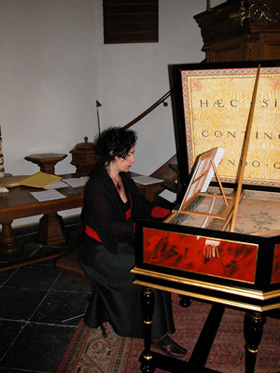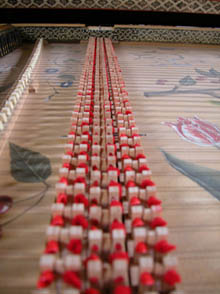
Clavicembalo Couchet 1652, copia di A.Kilström
Il Couchet 1652 è un esempio tipico di fattura di Anversa della dinastia Ruckers-Couchet: fasce spesse, tavola armonica dipinta a fiori e uccelli, un suono molto timbrato, robusto ma raffinato. La cassa è più grande e più larga che quella dei Rockers più antichi il che conferisce una nobiltà più grande allo strumento, soprattutto nel registro basso. Il clavicembalo fu trasformato in Francia aggiungendo un registro di 4 piedi e una seconda tastiera. Fu sempre in Francia che lo strumento venne sontuosamente arricchito da un decoro nello stile di Versailles con ghirlande e angeli dipinti su foglia d’oro che ne ricoprono la cassa e il basamento scolpito.
Andreas Kilström ha voluto ricostruire lo strumento nel suo assetto originale, prima della sua trasformazione in Francia, Il Clavicembalo Couchet soprattutto perchè a quel tempo possedeva una disposizione veramente degna di nota di tre file di saltarelli per due corde. C’erano duinque tre registri di 8 piedi con timbri diversi che il clavicembalista può suonare separatamente o in varie combinazioni. Quando gli 8 piedi della stessa corda suonano insieme si ottiene l’effetto assai sorprendente di un 8 piedi più l’ottava di un 4 piedi.
Kilström ha realizzato un decoro tartarugato, una tecnica sofisticata di pittura rossa e nera su di un fondo invisibile di foglia d’oro. Sulla tradizionale carta Ruckers all’interno del coperchio figurano degli arabeschi e un motto in latino: HAEC SI CONTIGANT MUNDO QUAE GAUDIA COELI (Se tali gioie si trovano sulla terra, quali mai saranno le gioie del cielo). Sul frontalino sopra la tastiera un secondo motto avverte il cembalista: NON NISI MOTA CANO (Non canto che quando vengo suonato).
Harpsichord Couchet 1652, copy by A. Kilström
Instrument building by the Ruckers-Couchet dynasty in Antwerp: thick sides, soundboard painted with flowers and birds, a robust but refined timbre. The case is larger and wider than the older Ruckers, giving the instrument greater nobility, particularly in the basses.
The harpsichord was transformed in France, where a 4’ stop was added, as well as a second keyboard. It was in France, too, that the instrument received its sumptuous Versailles decoration of garlands and angels painted on gold leaf, which covers the instrument’s whole case and base.
Andreas Kilström wanted to restore the The harpsichord Couchetinstrument to its pre-transformation state, especially since it originally had a rather remarkable arrangement of three rows of jacks for two strings. There are thus three 8’ of contrasting colours, which the harpsichordist can play separately or by combining them. When the 8’ of the same string play together, the rather amazing effect obtained is comparable to that of an 8’ plus the 4’ octave.
Kilström carried out decoration in imitation of a tortoise shell, a sophisticated technique of red and black paint on an invisible gold-leaf background. On the traditional Ruckers papers inside the cover are arabesques as well as a motto in Latin: ‘Haec si contigant mundo quae gaudia coeli’ (If such joys are found on earth, what will be the joys in Heaven). Above the keyboard, a second watchword alerts the harpsichordist: ‘Non nisi mota cano’ (I sing only when I am touched).
Xavier Vandamme
